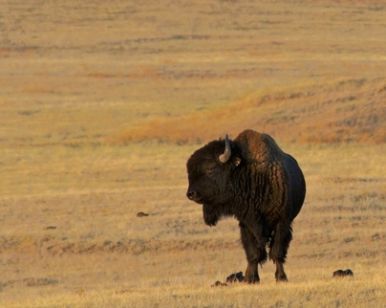
Parks Canada’s draft plan to bring plains bison back to Banff is a good one, according to a rancher who lives and works along the western edge of Prince Albert National Park, but it needs a stronger commitment to working with ranchers along the eastern slopes of the Rocky Mountains.
Gord Vaadeland, executive director of the Sturgeon River Plains Bison Stewards and a third generation rancher, said Tuesday (Oct. 23) building relationships with eastern slopes ranchers is key to ensuring the pilot project works: everything else – concerns over disease, roaming bison, broken fences and public safety – will fall away.
“I don’t think they are putting in enough significant effort into building relationships with folks on the eastern slopes,” Vaadeland said. “As a rancher, that is a gap I noticed. The park (Banff) needs to put effort into building relationships. There’s a lot of old wounds and before you risk creating any new wounds, you need to work on healing the old wounds and a presence here would be helpful to the long-term bison reintroduction.”
Part of that relationship building comes with having a Parks Canada employee who acts as a liason for ranchers in the region so that there is always “two boots on the ground with a person in them who is there to address (issues and concerns) on a regular basis and is available to people on the eastern slopes to talk to. To me, that is a gap. That is a gap (in the plan) and down the road if they fill that it will save them a lot of headaches and heartache.”
Parks opened the public consultation process seeking comments on the draft Plan for Reintroduction of Plains Bison in Banff National Park on Sept. 9. The public process ends Friday (Nov. 1). The plan can be found at www.parkscanada.gc.ca/banff-bison and comments can be sent to opinion@pc.gca.ca.
Currently, Parks is proposing a five-year pilot project to reintroduce 30 to 50 disease-free plains bison to the Panther-Dormer rivers region, a remote backcountry area of the park located along its eastern boundary.
Once the public comment period closes on Nov. 1, Parks intends to refine the proposal, producing a detailed action plan. An environment impact analysis, including fence studies and a disease analysis, would also occur.
If the project goes ahead, the draft plan calls for an evaluation at the end of the five-year-pilot project to decide if it should be expanded, scaled back or ended.
Erik Butters, a Municipal District of Bighorn councillor whose family has ranched in the Ghost River region since the 1930s, said the concern of his neighbours is that Parks could compromise the health of cattle in the eastern slopes region by re-introducing bison.
“Nobody wants to be the local president of the I-am-against-it society, but at the same time there are some legitimate concerns about that and people have a right to be concerned about animal health and animals like bison wandering around knocking down fences,” Butters said. “Hopefully, the Parks people will have a very good plan and be prepared to have contingencies in place in case they do wander out.”
Butters said he thought cattle ranchers would be more likely to support Banff’s draft plan if the federal government would take decisive action to control disease in Wood Buffalo National Park in northern Alberta.
Between 1925 and 1928, the federal government shipped 6,673 plains bison from Buffalo National Park at Wainwright to Wood Buffalo. The plains bison infected the larger wood bison with bovine tuberculosis and brucellosis. The result is that disease continues to challenge federal and provincial land managers.
“We work very hard in the cattle industry to have a very good health standard and that quite frankly is challenged by the Wood Buffalo area because there are diseased bison up there and the government is not willing to deal with it. If they had showed some willingness to deal with it there, it would give me more comfort here.
“I understand the Elk Island herd is a clean herd, but the Parks people do have a black mark in regards to that situation.”
The draft plan, however, does adequately address disease concerns, according to Cormack Gates, a professor in the Faculty of Environmental Design at the University of Calgary, who has been studying bison since 1983 and is a current IUCN (International Union for Conservation of Nature) Red List authority for American bison.
“I want to speak positively about the Banff proposal,” Gates said, “because it fits among the different conservation initiative projects. Bison are raised, in terms of the largest numbers, as captive, commercial propagation for the market. We’ve got probably approaching 500,000 animals now in that realm. There are organizations, nature conservancies and parks of various types that keep bison for the ecosystem services they provide and then there is a special category of bison conservation which refers to species conservation.”
For the full article by Rob Alexander in the Rocky Mountain Outlook, click here.

